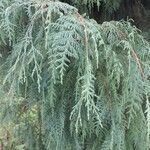An evergreen tree. It is a narrow cone shape and grows 15 m high. The bark is red brown and peels in strips. The leaves are needle like and slender. It is 6 mm long. They occur in rings of three and have sharp points. They are grey-green above. There are 2 white bands underneath. The leaves are dry and papery to touch. Male and female flowers occur in the same plant. Males are yellow and female flowers green. The fruit are berry-like and blue-black. They are 8 mm long.


